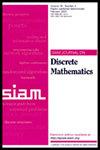Graphs without a Rainbow Path of Length 3
IF 0.9
3区 数学
Q2 MATHEMATICS
引用次数: 0
Abstract
SIAM Journal on Discrete Mathematics, Volume 38, Issue 1, Page 629-644, March 2024.Abstract. In 1959, Erdős and Gallai proved the asymptotically optimal bound for the maximum number of edges in graphs not containing a path of a fixed length. Here, we study a rainbow version of their theorem, in which one considers [math] graphs on a common set of vertices not creating a path having edges from different graphs and asks for the maximum number of edges in each graph. We prove the asymptotically optimal bound in the case of a path on three edges and any [math].
没有长度为 3 的彩虹路径的图形
SIAM 离散数学杂志》,第 38 卷第 1 期,第 629-644 页,2024 年 3 月。 摘要1959 年,Erdős 和 Gallai 证明了图中不包含固定长度路径的最大边数的渐近最优约束。在这里,我们研究的是他们定理的彩虹版本,其中我们考虑的是共同顶点集上的 [math] 图,这些图不包含来自不同图的边,并求解每个图中的最大边数。我们证明了在三条边和任意 [math] 路径情况下的渐近最优约束。
本文章由计算机程序翻译,如有差异,请以英文原文为准。
求助全文
约1分钟内获得全文
求助全文
来源期刊
CiteScore
1.90
自引率
0.00%
发文量
124
审稿时长
4-8 weeks
期刊介绍:
SIAM Journal on Discrete Mathematics (SIDMA) publishes research papers of exceptional quality in pure and applied discrete mathematics, broadly interpreted. The journal''s focus is primarily theoretical rather than empirical, but the editors welcome papers that evolve from or have potential application to real-world problems. Submissions must be clearly written and make a significant contribution.
Topics include but are not limited to:
properties of and extremal problems for discrete structures
combinatorial optimization, including approximation algorithms
algebraic and enumerative combinatorics
coding and information theory
additive, analytic combinatorics and number theory
combinatorial matrix theory and spectral graph theory
design and analysis of algorithms for discrete structures
discrete problems in computational complexity
discrete and computational geometry
discrete methods in computational biology, and bioinformatics
probabilistic methods and randomized algorithms.

 求助内容:
求助内容: 应助结果提醒方式:
应助结果提醒方式:


